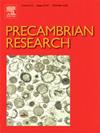Linking Hainan to Indochina through tectono-thermal records in metasedimentary rocks
IF 3.2
2区 地球科学
Q2 GEOSCIENCES, MULTIDISCIPLINARY
引用次数: 0
Abstract
Establishing accurate depositional ages and deciphering the tectono-thermal evolution of sedimentary sequences are essential for constraining their affinity and potential involvement in supercontinent cycles. This study presents an integrated U-Pb dating and trace element analysis on zircon, monazite, and rutile from the Shilu Group in Hainan, South China linking its Neoproterozoic depositional and metamorphic record to Indochina during the transition from Rodinia to Pangea. Based on the mineral assemblages, internal textures, and geochemical features of the accessory minerals from the sixth layer of the Shilu Group, magmatic zircon, metamorphic rutile, and both magmatic and metamorphic monazite are identified. Detrital zircons and monazites yielded the youngest weighted mean 206Pb/238U ages of 977 ± 13 Ma (MSWD = 1.2, n = 7) and 959 ± 7 Ma (MSWD = 1.8, n = 8), respectively. Metamorphic monazite and rutile grains produced age clusters at 948–816 Ma, 453–329 Ma, and 291–235 Ma, with the three oldest monazite grains yielding a weighted mean age of 946 ± 7 Ma (MSWD = 0.14). These geochronological data collectively suggest that the sixth layer of the Shilu Group was deposited around 960–950 Ma and experienced metamorphism during the intervals of 950–820 Ma, 450 Ma, 350 Ma, and 250 Ma. The documented metamorphic events closely parallel those observed within the Kontum Massif. This concordance, along with published data, suggests a geological connection between Hainan and Kontum from the early Neoproterozoic to the late Paleozoic.
确定沉积序列的准确沉积年龄和解密其构造-热演化过程对于确定其亲缘关系和可能参与超大陆循环至关重要。本研究对华南海南石碌组的锆石、独居石和金红石进行了U-Pb定年和痕量元素综合分析,将其新近纪沉积和变质记录与印度支那在罗迪尼亚向泛大陆过渡期间的沉积和变质记录联系起来。根据石碌组第六层附属矿物的矿物组合、内部纹理和地球化学特征,确定了岩浆锆石、变质金红石以及岩浆和变质独居石。块状锆石和独居石的最年轻加权平均 206Pb/238U 年龄分别为 977 ± 13 Ma(MSWD = 1.2,n = 7)和 959 ± 7 Ma(MSWD = 1.8,n = 8)。变质独居石和金红石晶粒产生的年龄群分别为 948-816 Ma、453-329 Ma 和 291-235 Ma,其中三个最古老的独居石晶粒产生的加权平均年龄为 946 ± 7 Ma(MSWD = 0.14)。这些地质年代数据共同表明,石碌组第六层沉积时间约为960-950 Ma,经历了950-820 Ma、450 Ma、350 Ma和250 Ma的变质作用。这些记录在案的变质事件与在孔图姆山丘内观察到的变质事件非常相似。这种一致性以及已公布的数据表明,从新近纪早期到古生代晚期,海南与孔图姆之间存在地质联系。
本文章由计算机程序翻译,如有差异,请以英文原文为准。
求助全文
约1分钟内获得全文
求助全文
来源期刊

Precambrian Research
地学-地球科学综合
CiteScore
7.20
自引率
28.90%
发文量
325
审稿时长
12 months
期刊介绍:
Precambrian Research publishes studies on all aspects of the early stages of the composition, structure and evolution of the Earth and its planetary neighbours. With a focus on process-oriented and comparative studies, it covers, but is not restricted to, subjects such as:
(1) Chemical, biological, biochemical and cosmochemical evolution; the origin of life; the evolution of the oceans and atmosphere; the early fossil record; palaeobiology;
(2) Geochronology and isotope and elemental geochemistry;
(3) Precambrian mineral deposits;
(4) Geophysical aspects of the early Earth and Precambrian terrains;
(5) Nature, formation and evolution of the Precambrian lithosphere and mantle including magmatic, depositional, metamorphic and tectonic processes.
In addition, the editors particularly welcome integrated process-oriented studies that involve a combination of the above fields and comparative studies that demonstrate the effect of Precambrian evolution on Phanerozoic earth system processes.
Regional and localised studies of Precambrian phenomena are considered appropriate only when the detail and quality allow illustration of a wider process, or when significant gaps in basic knowledge of a particular area can be filled.
 求助内容:
求助内容: 应助结果提醒方式:
应助结果提醒方式:


